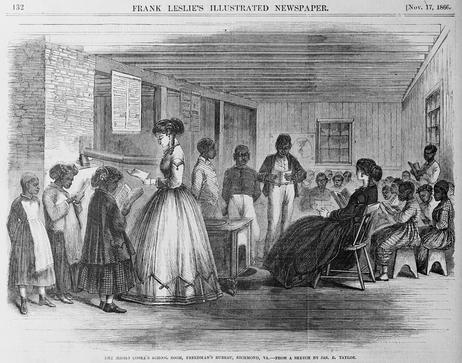Segregation in K-12 education has been a persistent issue throughout American history, with its roots tracing back to the Colonial Era. This essay examines the origins of segregation in K-12 education during that time and explores the differential treatment experienced by Native American, African American, and white students. By delving into the historical context and citing relevant sources, we can better understand how educational disparities based on race and ethnicity were established and perpetuated.
The Post-Revolutionary War Era marked a critical period in American history when the foundations of segregation in K-12 education were solidified. This essay delves into the historical context of this era and explores the consolidation of racial disparities in education. By examining the policies, attitudes, and events that shaped educational segregation, we can gain insights into the enduring consequences of this era.
The transition from Colonial to State Control
The Emergence of State Control over Education
With the end of the Revolutionary War, control over education shifted from colonial and religious institutions to state governments. This transition facilitated the consolidation of power in shaping educational policies.
Early State Laws and Segregated Education
Many states enacted laws during this era that explicitly segregated education based on race. For example, Massachusetts passed a law in 1789 requiring the establishment of racially separate schools, perpetuating educational disparities.
Expanding Racial Disparities in Education
Limited Educational Opportunities for African-American Students
African-American students faced severe limitations in accessing formal education. Many southern states enacted laws that explicitly prohibited the teaching of enslaved and free African Americans, perpetuating a cycle of illiteracy and subjugation.
Development of Racially Segregated Schools
The concept of "separate but equal" began to take hold during this era, laying the groundwork for racial segregation in schools. African American students were given underfunded and inferior facilities, resources, and teaching staff, perpetuating educational disparities.
Native American Boarding Schools
The federal government initiated a policy of forced assimilation by establishing Native American boarding schools. These schools sought to eradicate Native American cultures and languages, further marginalizing and erasing Native American identities.
Pioneering African American Educational Institutions
Rise of Independent African American Schools
Despite immense challenges, African-American communities established independent schools to educate their children. Prominent examples include the African Free Schools in New York City and the Institute for Colored Youth (later Cheyney University) in Pennsylvania.
This video offers an in-depth look at schooling for African Americans before and after the Civil War.
African American Educational Advocates
Influential figures such as Frederick Douglass, Maria Stewart, and David Walker emerged as strong advocates for African-American education. Their writings and speeches highlighted the importance of education in empowering marginalized communities.
Formation of Historically Black Colleges and Universities (HBCUs) The establishment of HBCUs, such as Howard University and Fisk University, provided crucial higher education opportunities for African-American students. These institutions played a pivotal role in nurturing intellectual and leadership development within the African-American community (The Journal of Blacks in Higher Education).
The Post-Revolutionary War Era witnessed the consolidation of racial disparities in K-12 education, as state control over education facilitated the enactment of laws and policies that perpetuated segregation. African American students faced limited educational opportunities, while racially segregated schools provided unequal resources and facilities. However, the era also saw the resilience and determination of African-American communities in establishing independent schools and advocating for educational equality. Understanding this historical context is essential for comprehending the long-lasting impact of segregation in education and inspires us to strive for a more equitable and inclusive educational system.
The Reconstruction Era and the Battle for Educational Equality
The Reconstruction Era following the American Civil War was pivotal in the fight for educational equality and dismantling segregation in K-12 education. This essay explores the historical context of the Reconstruction Era and its impact on educational opportunities for African-American students. By analyzing policies, initiatives, and the challenges faced during this period, we can gain insights into the progress made and the setbacks encountered in the pursuit of educational equality.
The Freedmen's Bureau and Educational Initiatives
Establishment of the Freedmen's Bureau
The Freedmen's Bureau, established in 1865, supported educational opportunities for formerly enslaved African Americans. It aimed to assist freed individuals in their transition to freedom and supported schools and teachers.
Creation of Freedmen's Schools
The Freedmen's Bureau established schools across the South, known as Freedmen's Schools, which provided formal education to African-American students. These schools were instrumental in expanding access to education and empowering African-American communities.
This video offers a look at freedman schools during Reconstruction.
Southern Black Codes and Educational Restrictions
Introduction of Southern Black Codes
Southern states implemented Black Codes, which sought to restrict the rights and freedoms of newly freed African Americans. These codes included provisions that limited educational opportunities for African-American students, perpetuating educational disparities.
Challenges Faced by African-American Schools
Despite efforts to establish schools for African-American students, they faced numerous challenges, including insufficient funding, inadequate facilities, and hostility from white supremacist groups. These obstacles hindered the progress of African-American education during Reconstruction.
The Rise and Fall of Integrated Education
Early Attempts at Integrated Education
During Reconstruction, there were brief periods in which integrated education was implemented in some Southern states. African American and white students attended schools together, reflecting the vision of educational equality.
Retreat from Integration
As Reconstruction ended, the retreat from integration gained momentum. The emergence of segregationist ideologies and the rise of Jim Crow laws led to the establishment of racially segregated schools, undoing the progress made during the earlier years of Reconstruction.
Legacy and Lasting Impact
Educational Advancements Despite Challenges
Despite the obstacles and setbacks faced during Reconstruction, African-American communities persevered in their pursuit of education. They established independent schools, churches, and educational institutions that laid the foundation for future advancements in African-American education.
Segregation's Lingering Effects
The legacy of segregation during Reconstruction had lasting effects on educational disparities. African-American students continued to face unequal resources, inadequate facilities, and limited opportunities, perpetuating educational inequalities for generations to come.
Conclusion
The Reconstruction Era represented a critical juncture in the battle for educational equality. While the Freedmen's Bureau and the establishment of Freedmen's Schools provided hope for African-American education, the rise of Black Codes and the retreat from integration hindered progress. Despite these challenges, African-American communities persisted in their quest for education, laying the groundwork for future advancements. Understanding the complexities and struggles of the Reconstruction Era helps us appreciate the ongoing battle for educational equality. It inspires us to continue working towards a more inclusive and equitable educational system.
More Resources
The sources used in this essay include
- "The Irony of Early School Segregation Laws" by Michael B. Katz
- "Education of Blacks in the South, 1860-1935" by James D. Anderson
- "Education for Extinction: American Indians and the Boarding School Experience" by David Wallace Adams
- "The Claims of the Negro, Ethnologically Considered" by Frederick Douglass
- The Journal of Blacks in Higher Education
- "The Freedmen's Bureau and Black Education" by John Hope Franklin
- "Remembering Jim Crow: African Americans Tell About Life in the Segregated South" by William H. Chafe
- "The Education of Blacks in the South, 1860-1935" by James D. Anderson "Reconstruction: America's Unfinished Revolution, 1863-1877" by Eric Foner
- "The Strange Career of Jim Crow" by C. Vann Woodward
Questions? Contact us on Facebook. @publicschoolreview
#PostRevolutionaryEra #EarlyAmericanEducation #EducationReforms #IndependentSchools #ReconstructionEra #CivilWarAftermath #EducationalAdvancements #EqualRights




















































































































































